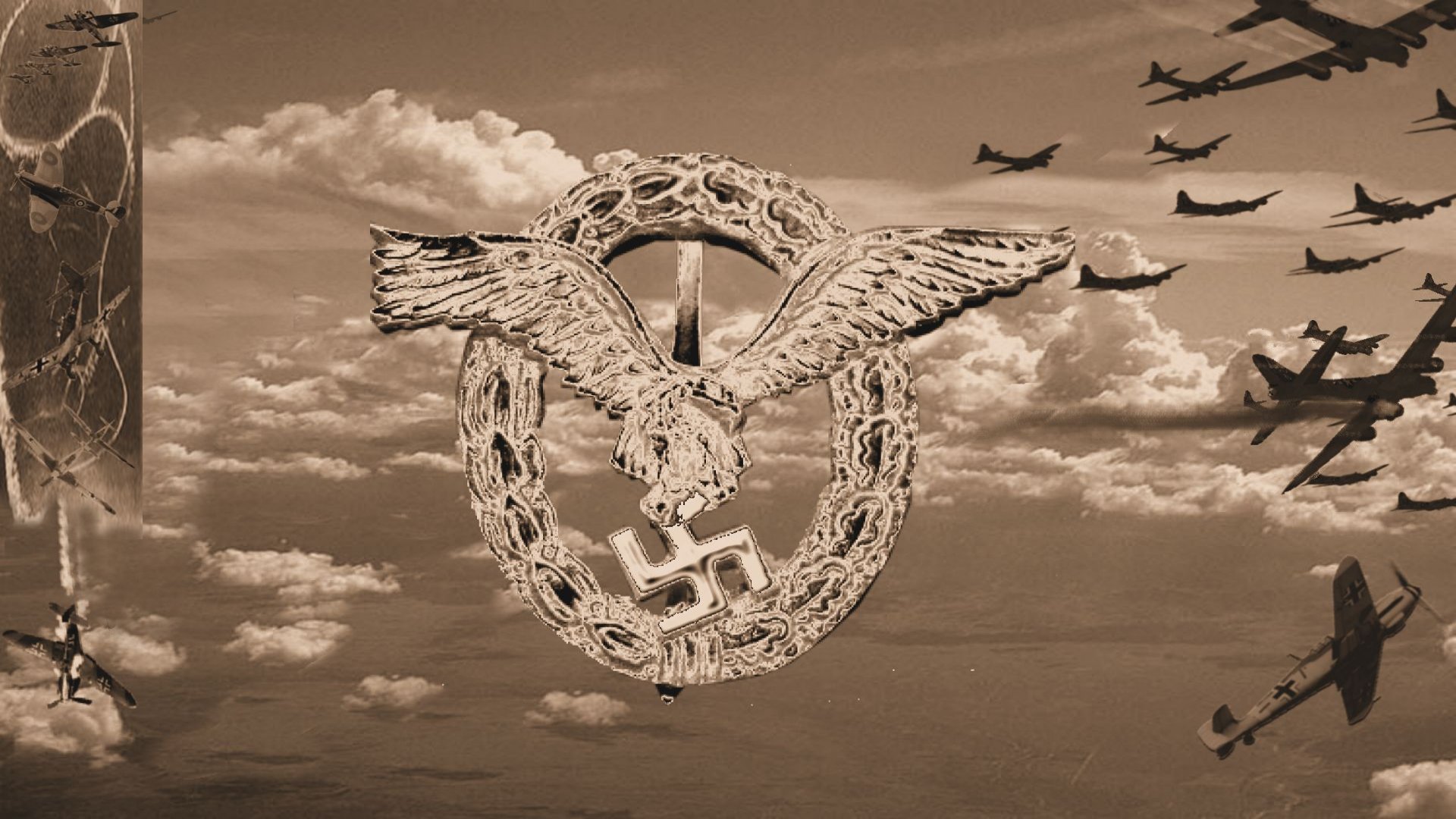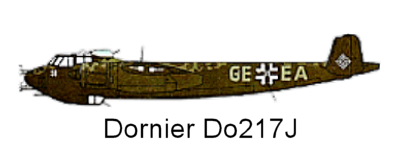


 Dornier Do-217 Dornier Do-217The Dornier Do 217 was a bomber used by the German Luftwaffe during World War II as a more powerful version of the Dornier Do 17, known as the Fliegender Bleistift ('flying pencil'). Designed in 1937 and 1938 as a heavy bomber but not meant to be capable of the longer-range missions envisioned for the June 3, 1936-dated Bomber A contract winning Heinkel He 177, the Do 217's design was refined during 1939 and production began in late 1940. It entered service in early 1941 and by the beginning of 1942 was available in significant numbers. Development At the beginning of 1938, Dornier issued manufacturing specification No. 1323, recognising the need for a twin-engine bomber or long-range reconnaissance aircraft powered by Daimler-Benz DB 601B engines. In February 1938 the 'Reichsluftfahrtministerium' (RLM - Air Ministry) authorized a testing program. Dornier worked on a version of the Do 17M with the all round vision cockpit of the Do 17Z and a fuselage having a large bomb bay capable of holding a maximum of two 500 kilograms (1,100 lb) and ten 50 kilograms (110 lb) bombs. For reconnaissance an Rb 50/30 movie camera was fitted ahead of the front spar of the wing, and an Rb 20/30 was mounted in the second bomb bay. Jettisonable fuel tanks were carried in the forward bomb bay. For smoke-laying, the aircraft could be fitted with two Type S200 smoke generators. Dornier also envisaged the Do 217 as a naval dive bomber, in which case it was to be fitted with twin floats. In April and May 1938, the Do 217 WV1 and WV2 prototypes were produced. The wing span was to be slightly larger than the Dornier Do 17 by one metre. Its overall span was now 20 metres (65 ft 7 in). Under the wing a retractable diving air brake was to be installed. To power the aircraft the Dornier office at Manzell had favoured two DB 601B engines which could generate 1175 PS (1159 hp, 864 kW) for take off. The Jumo 211, Bramo 329 and BMW 139 (forerunner to the BMW 801) were also considered. Whichever of the power plants was selected, the RLM expected the aircraft to achieve a maximum speed of 520 kilometres per hour (280 kn) and have a weight of 10,200 kilograms (22,500 lb) fully loaded. On 5 June 1938 Dornier's overview of its design submitted to the 'Technisches Amt' (Technical Bureau) highlighted some structural differences with the Do 17. In particular, the proposed increase in the bomb load to 1,500 kilograms (3,300 lb) had to have been a vital factor in the design's acceptance. The fuselage was to be not only bigger but also structurally stronger. Back to TopInto Action The pre-production A-0s were the first Do 217s to see service. In late 1940 they were allocated to a special reconnaissance Gruppe operating as part of the Luftwaffe High Command. Over the winter of 1940-41 they flew a series of reconnaissance missions over Russia, gathering information in advance of the upcoming invasion. The next unit to receive the Do 217 was II./KG 40, split between bases in Holland and around Bordeaux in western France. This anti-shipping unit received it's Do 217Es in the spring of 1941, and for the rest of the year was able to carry out relatively successful attacks on British coastal convoys. They were soon joined by KG 2, which was withdrawn from the Russian front in July 1941 to swap its Do 17s for Do 217s. These anti-shipping strikes became increasingly difficult in the first months of 1942 as British defences improved, but they only stopped when Hitler ordered a new bombing campaign over Britain. This campaign was triggered by one of Bomber Commands' first major raids, against Lübeck on 28 March 1942. This raid destroyed 1,425 buildings and damaged over 10,000. Hitler was predictably furious, and ordered a series of retaliation raids. These became known as the 'Baedeker' raids after a speech in which Hitler promised to destroy every city mentioned as of historical or artistic interest in a Baedeker guide book. These raids hit Bath, Exeter, Norwich, York, Cowes and Canterbury, (as well as Hull and Grimsby, presumably picked for different reasons.) These costly raids only ended in July, after raids against Birmingham and Hull resulted in the loss of 27 aircraft. The attrition continued in August. During the otherwise disastrous Dieppe raid, the only bright spot for the Allies were the heavy losses inflicted on the Luftwaffe. KG 2 lost 25% of its 80 aircraft in fighting around Dieppe. Back to Top Mediterranean Twelve Do 217 J-1 and J-2 variants were acquired by Italian Regia Aeronautica between September 1942 and June 1943 for night fighter operations. One Italian unit was equipped: 235a Squadriglia of 60° Gruppo (41° Stormo). Based at Treviso San Giuseppe, then at Lonate Pozzolo, the unit performed poorly. The unit shot down only one enemy aircraft, and lost one of their own, after nearly a year of activity. When the Italian Armistice with the Allies was announced on 9 September 1943, the Italian Fleet was instructed to sail to Malta to surrender. III/KG 100, based at Marseilles launched an attack from its base at comprising 11 Do 217s armed with Fritz-X guided bombs against Italian warships near Corsica, sinking the battleship Roma and damaging the battleship Italia. The Dorniers were then deployed against the Allied landings at Salerno, damaging the cruisers USS Savannah and HMS Uganda and the battleship HMS Warspite with Fritz X bombs. Hs 293 missiles also sank the cruiser HMS Spartan and several destroyers and merchant ships off Anzio in January 1944 until heavy allied fighter cover and jamming reduced the effectiveness of the attacks. Back to TopDefence of the Reich Deliveries of the Dornier Do 217J-1 started in March 1942, with night-fighter pilots being unimpressed, considering the type to have poor manoeuvrability and speed. The J-1 was relegated to the training role by summer that year, replaced by the radar equipped J-2 in front-line units. Despite the aircraft's faults, the Do 217 was widely used, being used by 11 night-fighter Gruppen, although it did not completely equip any unit, usually being operated in conjunction with the more popular Messerschmitt Bf 110. The Luftwaffe deployed the Do 217 night-fighter over Italy and the Eastern front as well as in direct defence of Germany, but the type had been phased out of service by mid-1944 The final significant Do 217 bomber operations came in June-August 1944. Attempts to attack the Allied fleets off the Normandy beaches failed with heavy losses, and allied air power over the beaches was overwhelming. On 7 August 1944 III./K.G. 100 took part in a desperate attack on a bridge over the River Selune, at Pontaubault. The attack failed to stop the allied advance and soon afterwards the unit was disbanded. Production of the Do 217 had ended in May 1944. Fuel shortages soon grounded the remaining German bomber units, and although a small number of Do 217s remained in service with reconnaissance units until the end of the war, its front line service as a bomber had come to an end. A total of 1,925 Do 217s of all types were produced. Back to Top |
|
|
Specifications(Do-217E-4):
Country of Origin: Germany Crew: 4 Wing span: 19.00m Length: 18.20m Height: 5.00m Powerplant: 2xBMW 801MA,1580h.p. Weight: Empty: 8860kg Loaded: 15000kg Performance Maximum speed: 510 km/h Service ceiling: 9000m Service range: 2050 km Armament Guns:1xMG-151 cannon (nose), two 13mm MG 131 machine guns, one in an EDL 131 electrical dorsal turret and 3 manual 7.9mm MG 15s Bombs: 4000kg/ 8,818lb bomb load, with 2517 kg/ 5550lb carried internally |